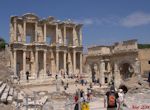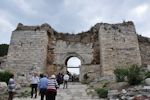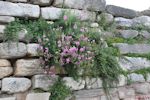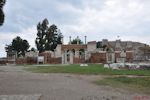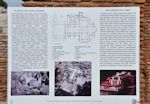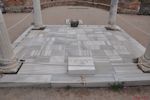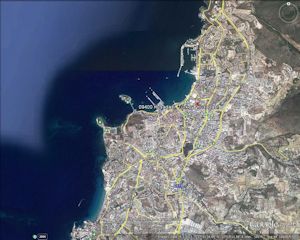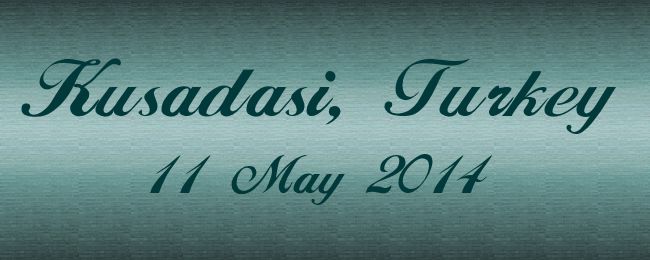
Links to Port Pages
Kusadasi, Turkey
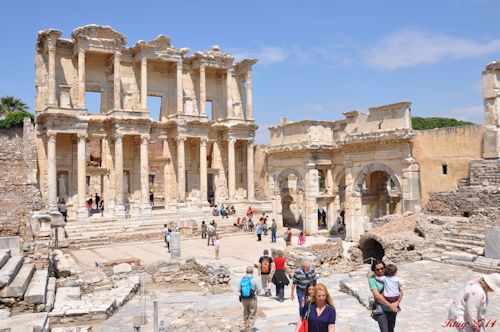 |
Photo by R Klug
Our Trip to Ephesus
We arrived in Kusadasi the morning of 11 May. We had the early tour to Ephesus and the Terrace Houses. After a bit of a drive we finally arrived at the site. I'm not sure what we really expected. The site is very large and set in an area of green rolling hills. In the ancient past the city was much closer to the Menderes River. In fact one of the gates to the city has a long paved road towards the river. There is more to Ephesus than the Celsus Library.
We selected the tour with the archaeologist and was very pleased. He was very informative and not dry, like some can be! He also had been involved in excavations of the Terrace Houses. His knowledge and insight made the tour extremely enjoyable. We started at the main gate near the upper class part of the town and walked past the baths and small theater. The Ephesians were very smart and had constructed clay pipes to move water, using gravity, to the homes in the area.
The terrace houses are located on the hill, opposite the Hadrian Temple. The more wealthy Ephesians lived in these homes which were constructed on the hillside. They were built according to the Hippodamian plan of the city in which roads transected each other at right angles.There are six residential units on three terraces at the lower end of the slope of the Bulbul Mountain. The oldest building dates back into the 1C BC and continued in use as residence until the 7C AD. The houses are covered with protective roofing which resembles Roman houses. They had interior courtyards (peristyle) in the center, with the ceiling open. They were mostly two-storied with living and dining rooms on the ground floor opening to the hall and upstairs there were bedrooms and guest rooms. You could see from the floor mosaics that the bedrooms (or sleeping rooms) were very small. The terrace houses were heated with water, same as in baths. Clay pipes beneath the floors and behind the walls carried hot air through the houses. The houses also had cold and hot water. The rooms had no window, only illuminated with light coming from the open hall, so that most of the rooms were dim.
Walking down the marble road from the terrace houses, we saw the temples and the Fountain of Pollio. We first saw it from the back as the large arch top still stands. Once you come down the street you can then see it from the front. The Pollio Fountain was built in 97 A.D by the rich Ephesian C.S.Pollio and his family. The water was brought to the fountains of Ephesus from three main sources through aqueducts and distributed from fountains by a branching system of baked clay pipes. Water was free of charge by the city in the public fountains.
Finally the library came in to view. It is an extraordinary structure and the details in the stone carvings are amazing. You could spend hours just walking in this area, but on a tour you have to keep moving along. We passed through the Gate of Mazeus and Mythridates to the Commercial Agora - the people's area. The gate with three passage ways at the right of the Celsus Library was built in 40 A.D by the slaves Mazeus and Mythridates for their emperor, Augustus, who gave them their freedom.
It was in the commercial agora that Paul spoke to the Ephesians. Standing in the grass amongst the old stones of the walkways was a moment of thoughtfulness. The realization of being in a place where Paul, John, and other Christians had preached and lived was moving.
The final view of the area was of the great theater which could seat 25,0000 people. From a distance it is incredible, up close, even more so.
We re-boarded our bus and headed to Selcuk and the Basilica St John. After Jesus' death, John was charged with taking care of Mary and the two of them settled in Turkey. We did not go to the House of the Virgin Mary but we could see it on the hills across from the Basilica.
Originally a chapel over the grave of St John, the emperor Justinian constructed a large basilica. What is extraordinary is the location is near the Isa Bey Mosque constructed in the 1370s and the Temple of Artemis completed in 550 BC. Christianity, Muslim, and Pagan (Greek gods) - all visible within the view.
We enjoyed a lunch at a typical Turkish restaurant and headed back to port. The only downside was the tour guide stopped at a rug store and was somewhat pushy that everyone had to go in and see the rugs. We, as well as a few others, had no interest in that. The guide would not take us back to port so we had to walk the rest of the way. Looking at the description of the tour, it should have been optional and the guide should have dropped us at the ship. A bit of a downer to the end of a great tour, but still we are so glad we visited Ephesus.
The ship's event of a concert at Ephesus was not conducted. May is a very rainy season in Kusadasi and the marble roads and sidewealks are very slick and dangerous. They have had some bad experiences with accidents and "drowned passengers" so they only conduct the concerts in the summer. Hopefully we will get to experience this next year!
Here's a video of our photos from Ephesus
Tour of Ephesus and the Terrace Houses - 11 May 2014
Celsus Library |
Close up details |
Gate to enter to St John's Basilica |
Flowers in the wall |
Basilica and Ayucuk Fortress on hill |
Basilica Signage |
Tomb of St John |
Baptismal |
Our evening dinner was shared with Colin Brown, the cruise director. He invited us to join him and several other guests. It was a wonderful evening with great conversation. We had the opportunity to get to know Colin better which continued throughout our cruise. After a few after dinner drinks in the lounge, we headed off to our cabin for a night's sleep before arriving in Santorini!
![]()
Pre-cruise posts
Updated: 25 January 2014
Kuşadası (pronounced [ˈkuʃadasɯ]) is a resort town on Turkey's Aegean coast and the center of the seaside district of the same name in Aydın Province. Kuşadası lies at a distance of 95 km (59 mi) to the south from the region's largest metropolitan center of İzmir, and 71 km (44 mi) from the provincial seat of Aydın situated inland. Its primary industry is tourism. The district neighbours on the northeast to Germencik district, on the southeast to Söke district, on the west to the Aegean Sea, and on the north to Selçuk district.
An outpost of Ephesus in ancient Ionia known as Pygela (Πύγελα), the area between the Büyük Menderes (Maeander) and Gediz (Hermos) rivers, the original Neopolis is thought to have been founded on the nearby point of Yılancı Burnu. Later settlements were probably built on the hillside of Pilavtepe, in the district called Andızkulesi today. Kuşadası was a minor port frequented by vessels trading along the Aegean coast. In antiquity it was overshadowed by Ephesus, until Ephesus' harbor silted up. From the 7th century BC onwards the coast was ruled by Lydians from their capital at Sardis, then from 546 BC the Persians, and from 334 BC along with all of Anatolia the coast was conquered by Alexander the Great. From then onwards the coastal cities in Anatolia were a centre of Hellenistic culture. (From Wikipedia)
![]()
What We Plan to See: Update: 25 January 2014
We scheduled our first tour for the visit to Kusadasi. We scheduled early as we really wanted this specific excursion and it is limited in participation. We are SO excited. Below is the description from the Silversea website -
"Ephesus & Terrace Houses with an Expert Archaeologist May 11 2014, 5-5.5 Hours
Explore the archaeological treasures of Ephesus and its unique terrace houses during a scenic and informative full-day Silver Shore Collection visit to this ancient city with lunch. Depart the pier for the visit to the Ephesus and meet your expert guide.
Ephesus After Istanbul's Sultanahmet area, the ruins of Ephesus are the most-visited landmarks in all of Turkey. The city ranks among the world's most beautiful classical cities, on par with Rome and Athens in scope, quality and feel. In ancient times, Ephesus hosted St. Paul, St. John and the Virgin Mary. Ephesus was an important Greek trading city of Ionia. Later, it became Rome's provincial capital and was home to one of the Seven Wonders of the Ancient World. The massive foundation of the Temple of Diana can still be seen here today after 3,000 years. In the 60s A.D., when the city supposedly had a population of nearly 150,000, St. Paul lived here for three years and wrote one of his most famous epistles, the Letter to the Ephesians.
Walking Tour Your guided walking tour commences at the Magnesium Gate, and proceeds downhill at a leisurely pace through Ephesus' marble streets. Along the way, your guide points out historically-significant sites, including the gymnasium, Temple of Hadrian, Upper Agora, Roman Baths, and more.
Terrace Houses Next, continue on to the recently-renovated Terrace Houses, which are the focus of this tour. Built during the reign of Augustus on the slopes of Bulbul Mountain, they were inhabited by wealthy Ephesians until the 7th century A.D., according to evidence from excavations. The houses on the upper slopes are reached via steps, and constructed so that the roof of one house forms the terrace of the house above it. All were peristyle, featuring a pool in the centre, with the rooms arranged around the pool. There was running water to the houses, either from a fountain or along the side. These restored houses are finely-decorated with marble floors, and walls adorned with exquisite mosaics and frescoes.
Celsus Library Your last stop is the exquisite Celsus Library. Built in 135 B.C. by a son in homage to his father, this magnificent library is lavishly decorated with facades, columns and sculptures. The library once housed 12,000 scrolls of papyrus manuscripts, making it one of the largest in the ancient world and second only to the library in Alexandria, Egypt.
Greek Theatre Just a short walk away is the spectacular Greek Theatre. Originally built in the 3rd century by the Greeks, the theatre was later expanded to its present capacity of 24,000. From this theatre, which has a row of seats 100 feet (30 metres) above the orchestra, St. Paul preached to the Ephesians, imploring them to give up their worship of Artemis and embrace the Christian faith.
St. John's Basilica Your last stop is at the nearby Basilica of St. John, one of the most significant religious monuments of its time. Built in the 6th century to replace the small basilica at the site of St. John's Tomb, the church signifies a major move from the ancient Roman cults to Christianity. Much of the basilica was constructed using materials from the famous Temple of Artemis, one of the Seven Wonders of the Ancient World.
Following your visit, re-board your coach for the short drive to a local restaurant to relax and enjoy lunch before making the return drive to Kusadasi. Upon arrival, you may opt to be taken directly to the ship, or remain in town for a carpet demonstration, shopping and return to the pier at your leisure."
Our itinerary will also include a special event - Evening Concert at Ephesus
"Silversea is pleased to offer our guests this exclusive evening event at one of Turkey's most famous and best preserved places of antiquity - Ephesus.
After an early dinner on board, coaches will be ready to take you to Ephesus, about a 20-minute drive from the port. Arriving at the site, guests from Silver Wind will proceed on foot through a wide marble road to one of the largest libraries of the ancient world. Between 12,000 and 15,000 scrolls were housed in the grand Library of Celsus in the Roman city, Ephesus. Designed by the Roman architect Vitruoya, the library was built in memory of Celsus Polemeanus, who was a Roman senator, General Governor of the Province of Asia, and a great lover of books.
Guests participating from Silver Spirit will proceed on foot to Odeon for the concert. The semi-circular theater was built in the 2nd century AD. Its lower tiers of marble benches are original; the remaining tiers have been reconstructed.
In either of these dramatic settings, you are treated to the wonderful music of famous composers, such as Vivaldi, Boccherini, Mozart, Bach and Faure, which take on a special meaning in the spellbinding atmosphere of Ephesus. Refreshments served during intermission will further enhance the special mood of the evening.
At the end of the performance, make your way back to the coaches and conclude this magical evening with the return drive to Kusadasi and the ship."
So our plan is set for a wonderful day and evening at Ephesus!
![]()
Kusadasi is the port to reach Ephesus, one of our "Bucket list" sites. We plan to use our stop in Kusadasi to spend the day in Ephesus and possibly visiting the famous Terrace Houses as well as the library and other archaeological sites.
So it's a definate that at this port we will go see the Terrace Houses, Celsus Library, Greek Theater, and St John's Basilica. Tours to the Terrace Houses, which are located opposite the Hadrian Temple are usually limited and controlled. One of the tours offered through the cruise line includes a visit to the houses. Silversea also conducts an evening concert hosted at the Library. We definately will be enjoying that event.
For more information about Ephesus, check out Wikipedia.
![]()
